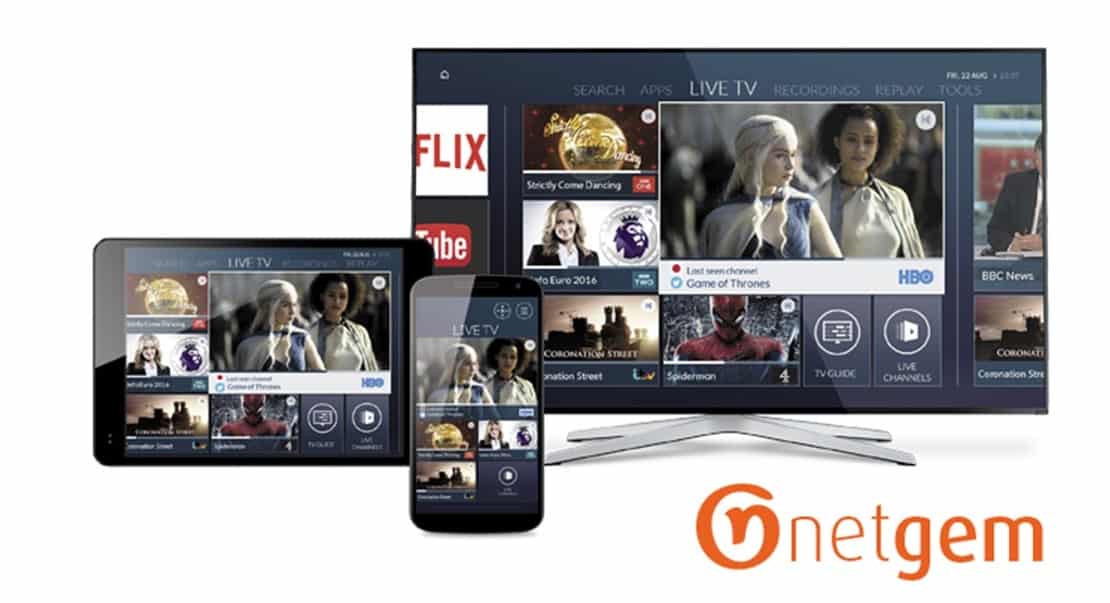The traditional ways of delivering TV content are changing. While OTT and streaming services are growing in popularity, digital aerial (DTT) and satellite delivery are struggling to maintain market share. With demand growing to provide high quality and high bandwidth content, 2017 will see telecoms operators harness their infrastructures to begin offering more 4K and OTT-delivered content to the mass market and truly act as differentiators to consumers.
#1: CONSUMERS WILL DEMAND 4K

Sylvain Thevenot,
Managing Director,
Netgem
Despite 55 million 4K TV sets expected to be sold globally in 2016, it is yet to achieve mass appeal. 3D TV saw a similar situation, where sets were made available, but not the level of content initially expected by manufacturers. However, in part due to 4K delivering a better quality image without any accessories and a steadily reducing price point, it has greater potential to appeal to consumers. So why has not been taken up yet? Currently there is limited availability of programming, so despite having 4K-ready TVs viewers do not have access to a stream of 4K content that they’re increasingly demanding. Despite there being some technical challenges in broadcasting 4K for operators, there are now a number of enablers that are in place to make 2017 the year for 4K:
- Better bandwidth and faster internet
Internet in consumers’ homes has increased in speed significantly with the fast-paced roll out of fibre. According to OFCOM, the average internet speed in the UK has increased to 22.8MB, seeing the largest rise recorded since 2014. The improved bandwidth and reliability means that more homes now have the ability to stream 4K content without buffering or delays. Improved compression technologies also now require less bandwidth to transmit and receive 4K content. Telcos simply cannot afford to ignore the growing demand for more and faster access to data, and 4K is going to form a key part of that call for more IP-delivered content. - Online and multiscreen delivery
The growing prevalence of 4K means consumers are starting to watch 4K content without even realising it by streaming video on YouTube, Netflix and other IP-delivered channels on their tablets and mobile screens. Amazon, for example, is already offering a wide range of 4K quality content amongst its 4,000 programmes, including The Grand Tour. By having access to 4K content through a range of delivery mechanisms, consumer demand will grow rapidly in 2017 for more UHD content in a multiscreen environment, much like HD is the expected standard now. - 4K content creation will be more affordable
Recording 4K definition has previously been more expensive than SD or HD, but there has been a significant rise in the number of production studios that are now investing in 4K recording equipment. The more common 4K production becomes, the more affordable it is, as the demand and supply equilibrium equals out and pricing becomes competitive. Consequently, it is likely that there will be a surge of content becoming available to consumers in 4K. Initially it will be rolled out as a premium offering and will then quickly become mass market. It is vital that telecoms operators don’t miss the 4K revolution if they want to maintain relevance amongst an increasingly tech savvy and demanding consumer audience. Telcos are looking at what content is currently available and once more programmes are created, adoption will become a natural progression. As 4K requires higher bandwidth, it provides more incentives for consumers to upgrade to better broadband, and vice versa, meaning that adoption of 4K and fibre are linked. We also need to reconsider how easy it is to bring content into the market. Internet providers can bring content at the speed of the internet, but some television providers are held back by the speeds and technology of a by traditional aerial and scheduling restrictions. Yet another reason to jump embrace the OTT surge over traditional broadcast services to deliver new quality standards. Customers are also starting to expect more for their money and will no longer settle for less. If they splurge on a TV that’s 4K ready, they want to watch 4K content – it’s as simple as that.
#2: OTT WILL BE THE NEW NORMAL
- Streaming Smartphone usage has grown significantly over the past few years. Research by Juniper Research predicts that annual cellular data traffic will reach 129,000 PB (Petabytes) by 2018, equivalent to approximately 14 billion hours of 4K video streaming. Recent technological advancements, such as 4G, have meant the devices in our pockets have more computing power with faster connection speeds available. This has had an impact on the TV industry too, with many consumers now choosing to watch content on their mobile or tablet devices, not just on their TV or PC. There has been a penetration of streaming in households, specifically in younger generations of viewers who don’t’ want to just watch their favourite shows on the TV anymore. Increasing demands to consume content where and when it’s convenient, means that 2017 will see increasing uptake of OTT as better network connections become established, in the way that 3G revolutionised better mobile connections. With 5G the next step in the mobile connection pipeline, demand for mobile streaming will only increase as it becomes an expectation as part of data packages, not a service just for premium services. This is particularly true with millennials who want to be able to access content at the speed of the internet. If it’s possible in the home, then it should be possible on the move.
- Cost benefits For Telecom operators, OTT is enabling them to embrace a new option to their proposition to consumers that can be delivered through their existing architectures, therefore keeping running costs down. One such example is POST Luxembourg, which uses OTT to offer its customers with fast and high-quality programming delivered via IP, including 4K multiscreen streaming. Doing so is proving a cost-effective way of offering new services to consumers that enables POST Luxembourg to expand its footprint and grow revenue
- OTT already accounts for more than 50 percent of all consumed content. With the majority of content now provided using OTT, it is critical for operators to embrace this means of content distribution and create their own experience customers. Consumers have become lazy. We have started to expect everything quicker and better than before, and if we can order a parcel to arrive in two hours, we expect to be able to instantly stream a movie or TV show wherever we choose. If operators blend the world of traditional TV and OTT and present everything in the same place, the average consumer will be able to easily access any type of content at the same time, without having to manually switch between programme guides and on-demand apps. This also provides potential to surface content in a systematic way that makes it easier for consumers to find the content they want to watch, all in one place. The UK’s EE is one such operator successfully providing this service by effectively surfacing linear programming alongside almost 40 OTT content partners to deliver more than 500 channels, representing 20,000 on demand titles to its customers.
The traditional TV model is changing, and now is the time for telecoms operators to seize the opportunities available with 4K programming and OTT content delivery. With the rise of 4K content production, and more competitors jumping aboard to drive prices down, telcos need to be providing the highest quality content for their viewers, to go along with their fast internet speeds and multiple Ultra HD screens. This is a great way to differentiate themselves in the market, and shape new revenue streams to ensure a successful 2017.
About The Author:
Managing Director of Netgem TV PVX: Sylvain joined the Executive Committee of Netgem in 2015, co-founding our new company based in London, created to deliver #TelcoTV - the Best Multi-screen experience, a Fantastic Range of Content, and Operational Excellence - to our telco customers. This has been demonstrated by the launch of the innovative ‘EE TV’ product in October 2014, which Sylvain lead when in charge of EE Broadband, and now managed in-life end-to-end by Netgem PVX. Sylvain brings a successful track record of designing new products with customer experience at the heart, and rolling them out internationally, as he did for market leading Communications and Content applications across 30 countries in Vodafone. In addition, based on his 20 years’ experience of running large fixed and mobile telecoms P&Ls (TalkTalk, Vodafone, EE), Sylvain is now leading Netgem’s new approach of ‘TV as a Managed service’ – delivering both short time-to-market and ongoing innovations to Quad-play operators – as well as flexibility in business models.




















